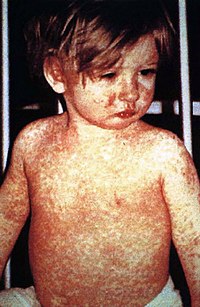
Photo from wikipedia
Gestational trophoblastic neoplasms (GTN) are highly curable tumors, with an overall patient survival of 90%, due to the individualized chemotherapy. However, chemotherapy regimens vary between different treatment centers and the… Click to show full abstract
Gestational trophoblastic neoplasms (GTN) are highly curable tumors, with an overall patient survival of 90%, due to the individualized chemotherapy. However, chemotherapy regimens vary between different treatment centers and the comparable benefits and risks of these different regimens are unclear. Here, we reported a case of GTN with oculocutaneous albinism (OCA) is resistant to fluorouracil (5-FU), extremely sensitive to actinomycin D (Act-D) with severe hand–foot skin reaction (HFSR). We hypothesized that the known, or unknown, gene mutations might be correlated with drug resistance, supersensitivity and severe drug side effects in OCA patients. Thus, we considered that OCA related genes influence some drug sensitivity and that the absence of melanin likely contributes to some drug resistance. It is important to assess the OCA related gene mutations locus of drug sensitivity, and resistance in OCA patients in future research.
Journal Title: OncoTargets and therapy
Year Published: 2019
Link to full text (if available)
Share on Social Media: Sign Up to like & get
recommendations!